TOYOTA MATRIX 2009 E140 / 2.G Manual Online
Manufacturer: TOYOTA, Model Year: 2009, Model line: MATRIX, Model: TOYOTA MATRIX 2009 E140 / 2.GPages: 440, PDF Size: 9.39 MB
Page 81 of 440
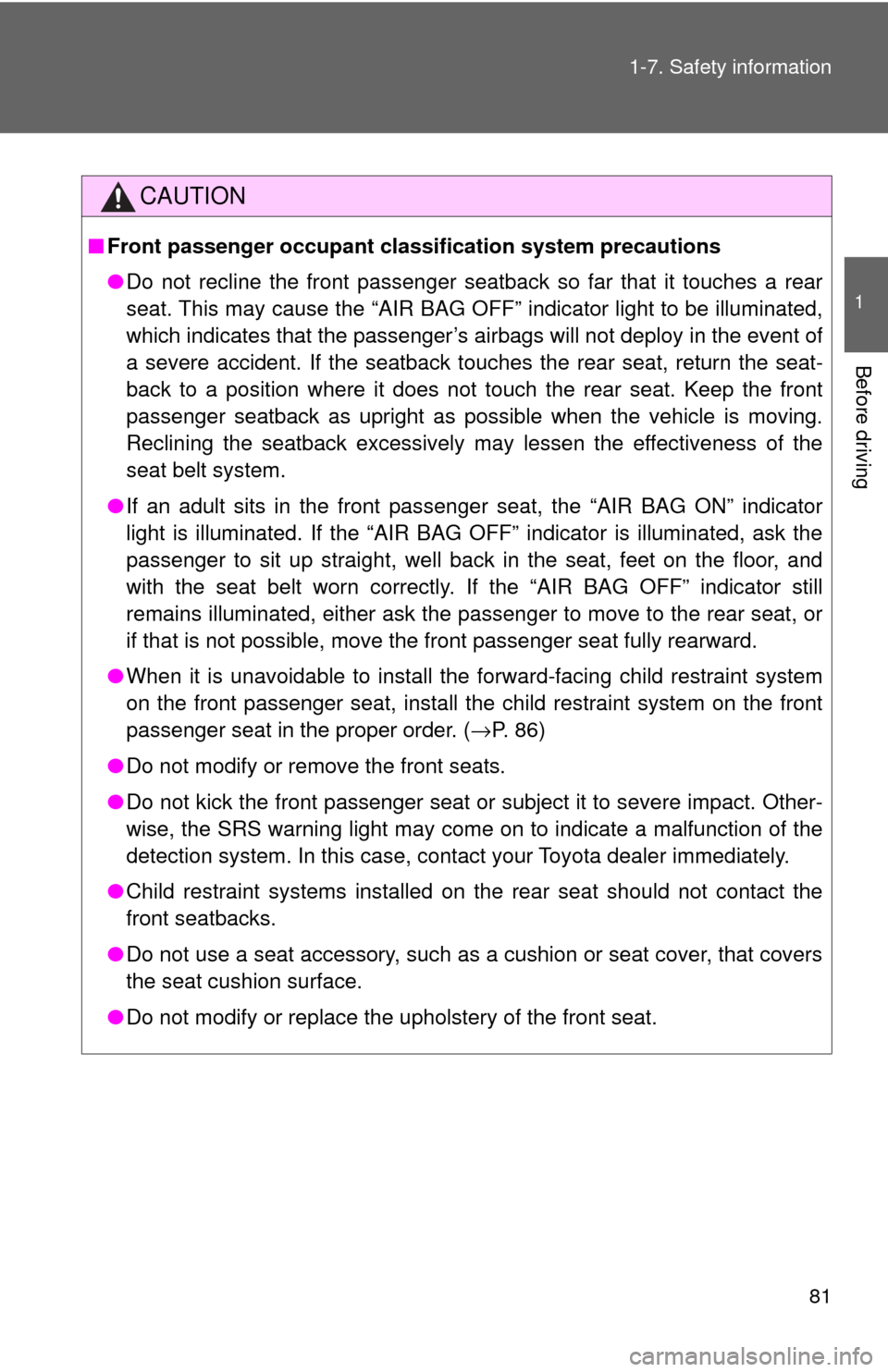
81 1-7. Safety information
1
Before driving
CAUTION
■Front passenger occupant classification system precautions
●Do not recline the front passenger seatback so far that it touches a rear
seat. This may cause the “AIR BAG OFF” indicator light to be illuminated,
which indicates that the passenger’s airbags will not deploy in the event of
a severe accident. If the seatback touches the rear seat, return the seat-
back to a position where it does not touch the rear seat. Keep the front
passenger seatback as upright as possible when the vehicle is moving.
Reclining the seatback excessively may lessen the effectiveness of the
seat belt system.
●If an adult sits in the front passenger seat, the “AIR BAG ON” indicator
light is illuminated. If the “AIR BAG OFF” indicator is illuminated, ask the
passenger to sit up straight, well back in the seat, feet on the floor, and
with the seat belt worn correctly. If the “AIR BAG OFF” indicator still
remains illuminated, either ask the passenger to move to the rear seat, or
if that is not possible, move the front passenger seat fully rearward.
●When it is unavoidable to install the forward-facing child restraint system
on the front passenger seat, install the child restraint system on the front
passenger seat in the proper order. (→P. 86)
●Do not modify or remove the front seats.
●Do not kick the front passenger seat or subject it to severe impact. Other-
wise, the SRS warning light may come on to indicate a malfunction of the
detection system. In this case, contact your Toyota dealer immediately.
●Child restraint systems installed on the rear seat should not contact the
front seatbacks.
●Do not use a seat accessory, such as a cushion or seat cover, that covers
the seat cushion surface.
●Do not modify or replace the upholstery of the front seat.
Page 82 of 440
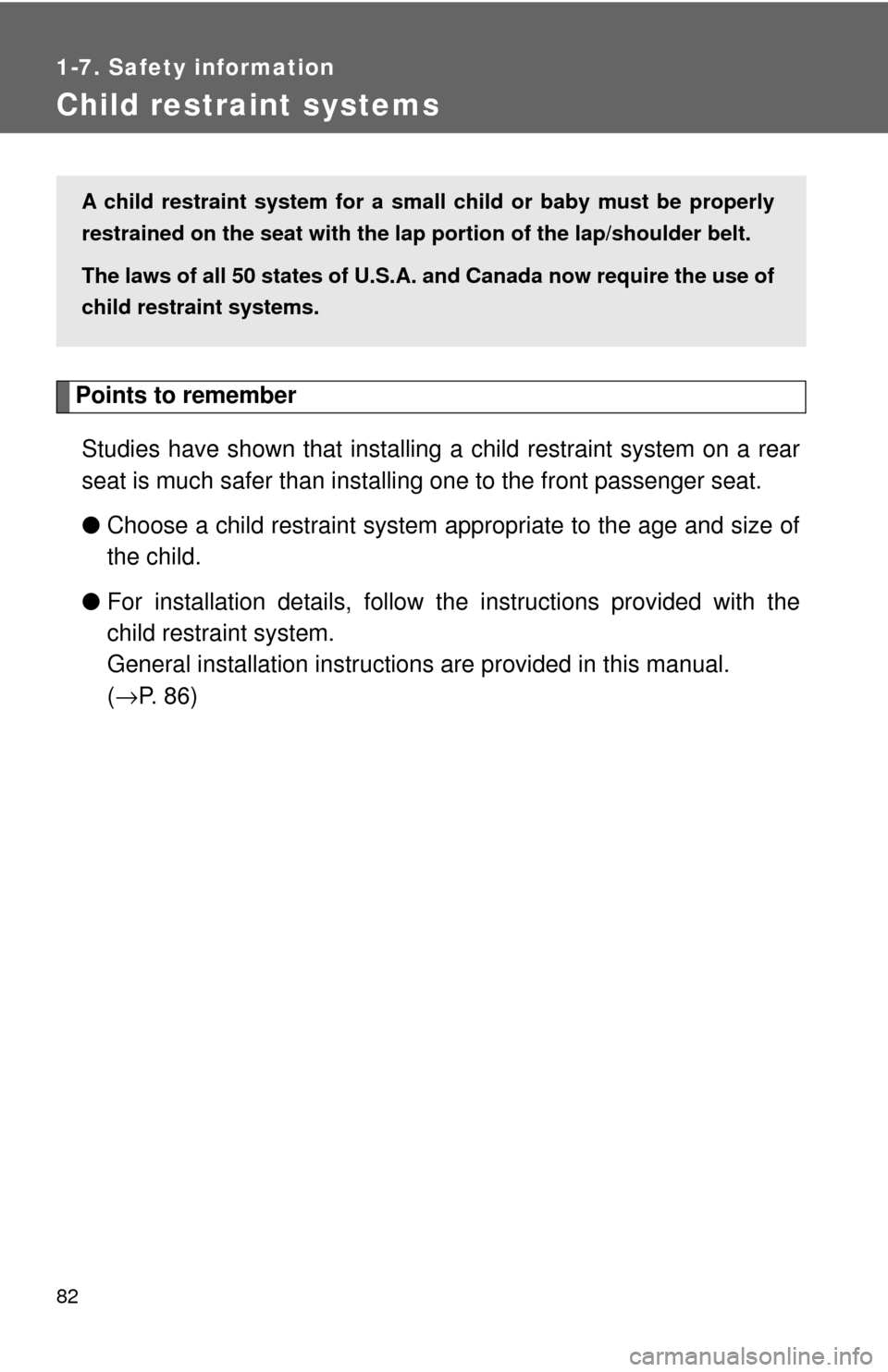
82
1-7. Safety information
Child restraint systems
Points to remember
Studies have shown that installing a child restraint system on a rear
seat is much safer than installing one to the front passenger seat.
●Choose a child restraint system appropriate to the age and size of
the child.
●For installation details, follow the instructions provided with the
child restraint system.
General installation instructions are provided in this manual.
(→P. 8 6 )
A child restraint system for a small child or baby must be properly
restrained on the seat with the lap portion of the lap/shoulder belt.
The laws of all 50 states of U.S.A. and Canada now require the use of
child restraint systems.
Page 83 of 440
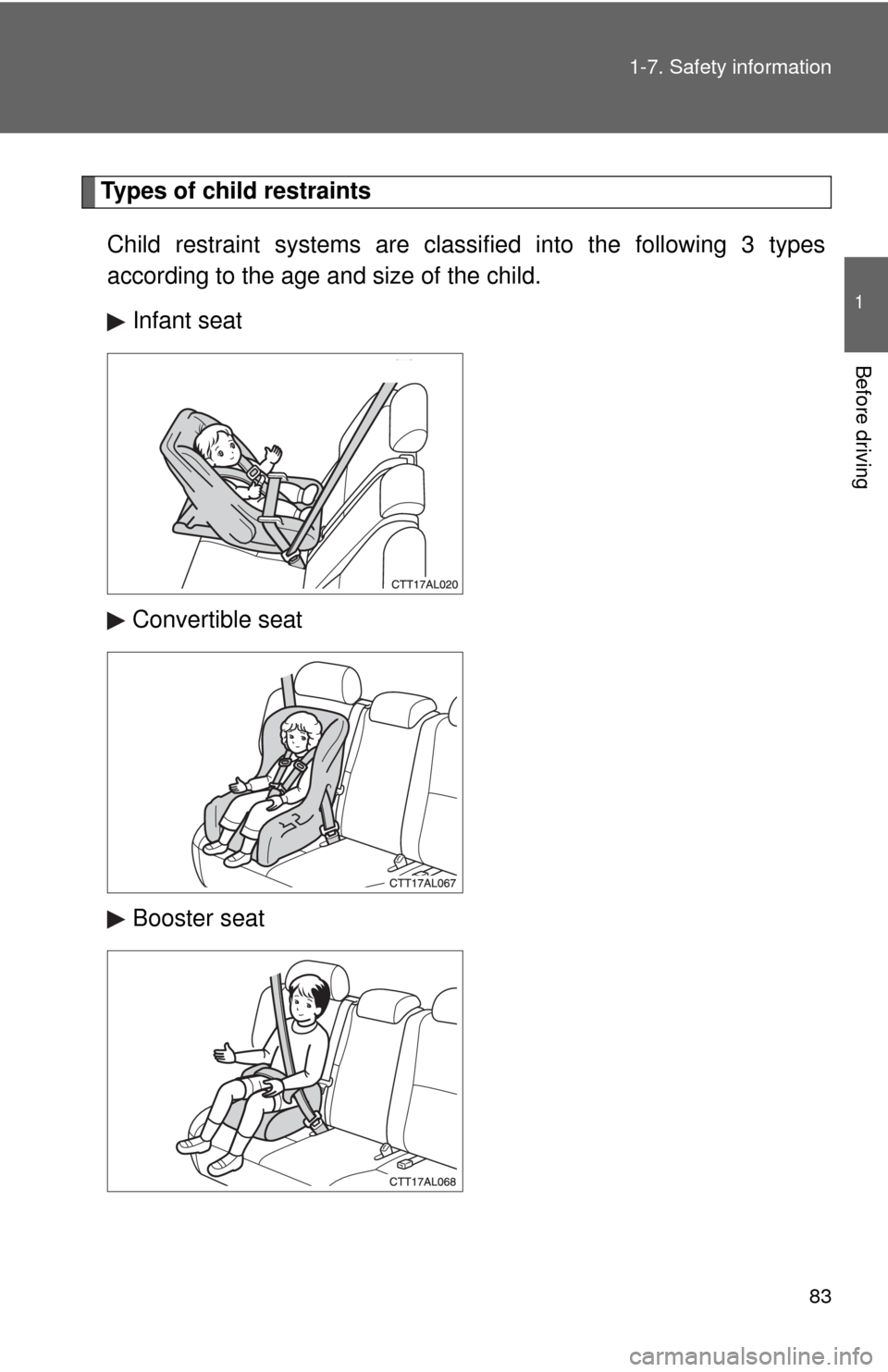
83 1-7. Safety information
1
Before driving
Types of child restraints
Child restraint systems are classified into the following 3 types
according to the age and size of the child.
Infant seat
Convertible seat
Booster seat
Page 84 of 440
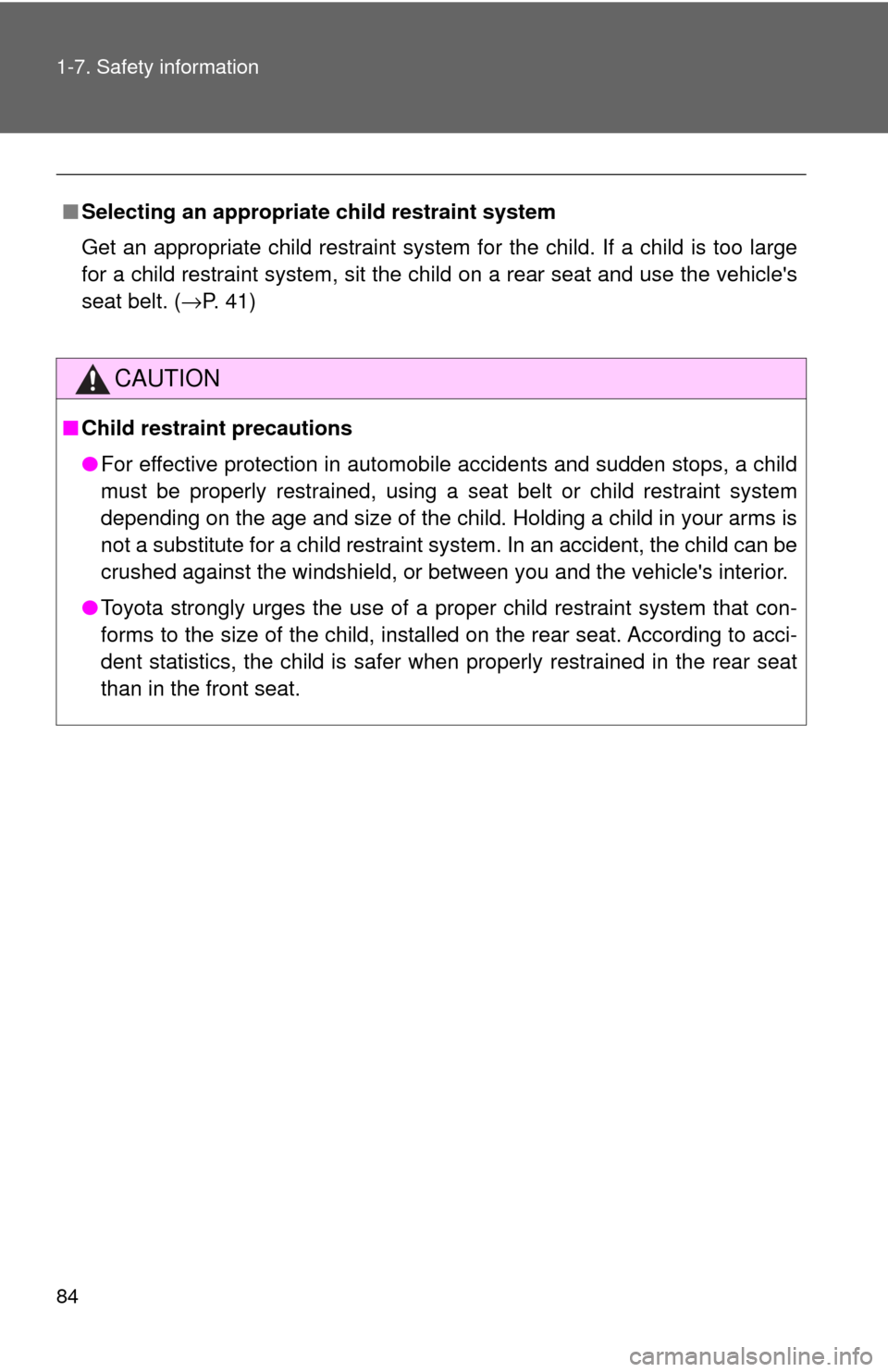
84 1-7. Safety information
■Selecting an appropriate child restraint system
Get an appropriate child restraint system for the child. If a child is too large
for a child restraint system, sit the child on a rear seat and use the vehicle's
seat belt. (→P. 41)
CAUTION
■Child restraint precautions
●For effective protection in automobile accidents and sudden stops, a child
must be properly restrained, using a seat belt or child restraint system
depending on the age and size of the child. Holding a child in your arms is
not a substitute for a child restraint system. In an accident, the child can be
crushed against the windshield, or between you and the vehicle's interior.
●Toyota strongly urges the use of a proper child restraint system that con-
forms to the size of the child, installed on the rear seat. According to acci-
dent statistics, the child is safer when properly restrained in the rear seat
than in the front seat.
Page 85 of 440
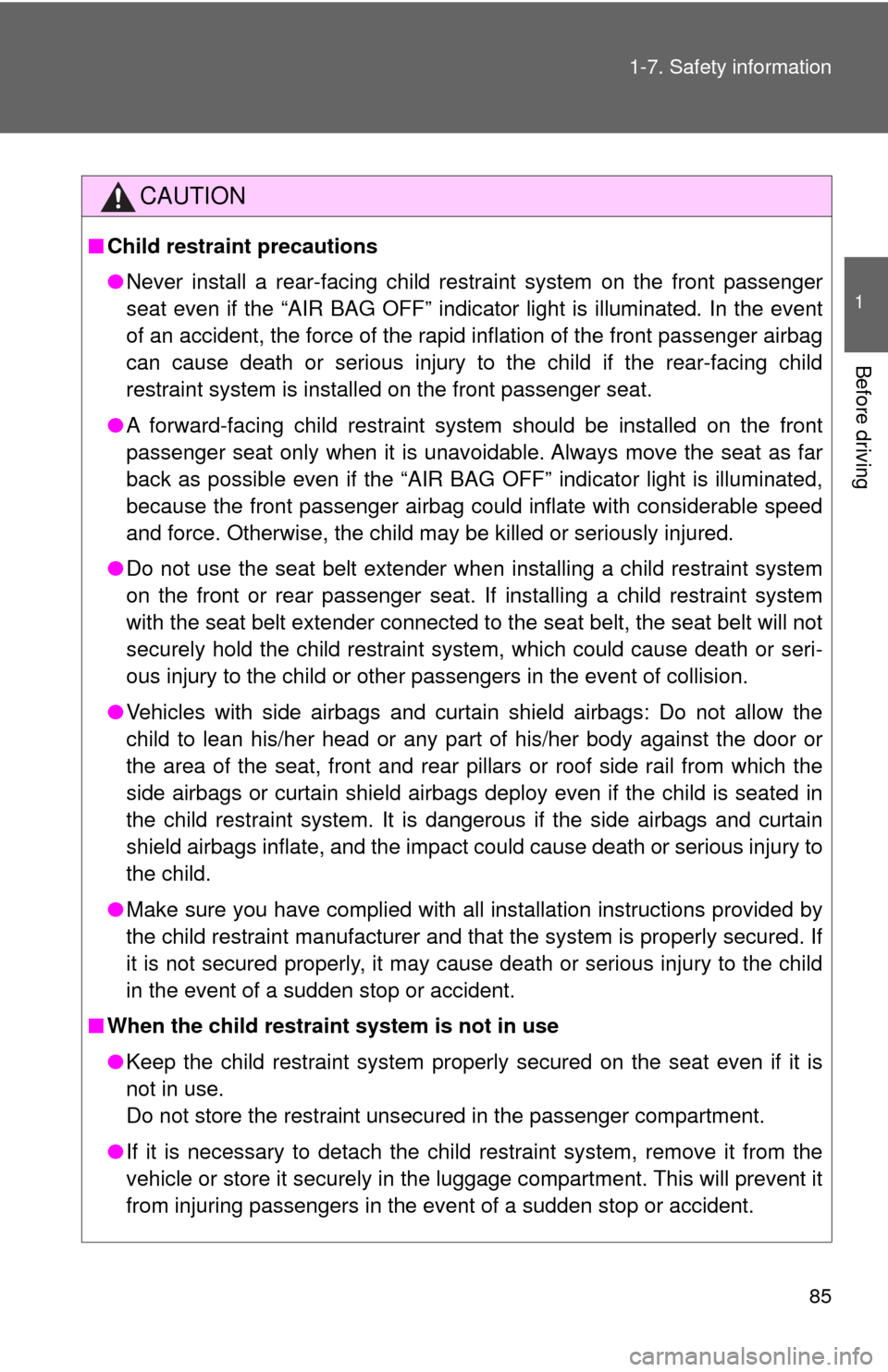
85 1-7. Safety information
1
Before driving
CAUTION
■Child restraint precautions
●Never install a rear-facing child restraint system on the front passenger
seat even if the “AIR BAG OFF” indicator light is illuminated. In the event
of an accident, the force of the rapid inflation of the front passenger airbag
can cause death or serious injury to the child if the rear-facing child
restraint system is installed on the front passenger seat.
●A forward-facing child restraint system should be installed on the front
passenger seat only when it is unavoidable. Always move the seat as far
back as possible even if the “AIR BAG OFF” indicator light is illuminated,
because the front passenger airbag could inflate with considerable speed
and force. Otherwise, the child may be killed or seriously injured.
●Do not use the seat belt extender when installing a child restraint system
on the front or rear passenger seat. If installing a child restraint system
with the seat belt extender connected to the seat belt, the seat belt will not
securely hold the child restraint system, which could cause death or seri-
ous injury to the child or other passengers in the event of collision.
●Vehicles with side airbags and curtain shield airbags: Do not allow the
child to lean his/her head or any part of his/her body against the door or
the area of the seat, front and rear pillars or roof side rail from which the
side airbags or curtain shield airbags deploy even if the child is seated in
the child restraint system. It is dangerous if the side airbags and curtain
shield airbags inflate, and the impact could cause death or serious injury to
the child.
●Make sure you have complied with all installation instructions provided by
the child restraint manufacturer and that the system is properly secured. If
it is not secured properly, it may cause death or serious injury to the child
in the event of a sudden stop or accident.
■When the child restraint system is not in use
●Keep the child restraint system properly secured on the seat even if it is
not in use.
Do not store the restraint unsecured in the passenger compartment.
●If it is necessary to detach the child restraint system, remove it from the
vehicle or store it securely in the luggage compartment. This will prevent it
from injuring passengers in the event of a sudden stop or accident.
Page 86 of 440
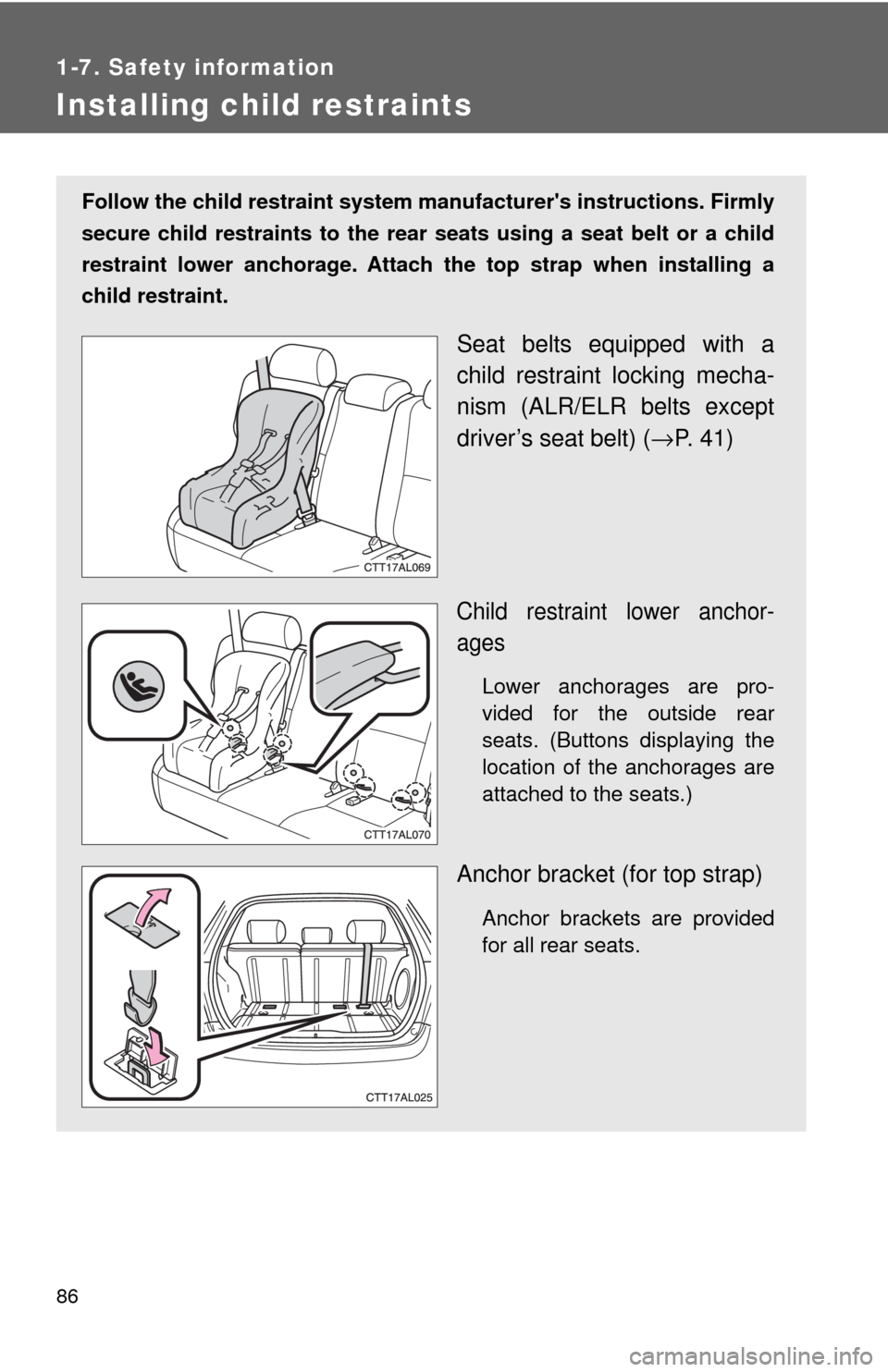
86
1-7. Safety information
Installing child restraints
Follow the child restraint system manufacturer's instructions. Firmly
secure child restraints to the rear seats using a seat belt or a child
restraint lower anchorage. Attach the top strap when installing a
child restraint.
Seat belts equipped with a
child restraint locking mecha-
nism (ALR/ELR belts except
driver’s seat belt) (→P. 41)
Child restraint lower anchor-
ages
Lower anchorages are pro-
vided for the outside rear
seats. (Buttons displaying the
location of the anchorages are
attached to the seats.)
Anchor bracket (for top strap)
Anchor brackets are provided
for all rear seats.
Page 87 of 440
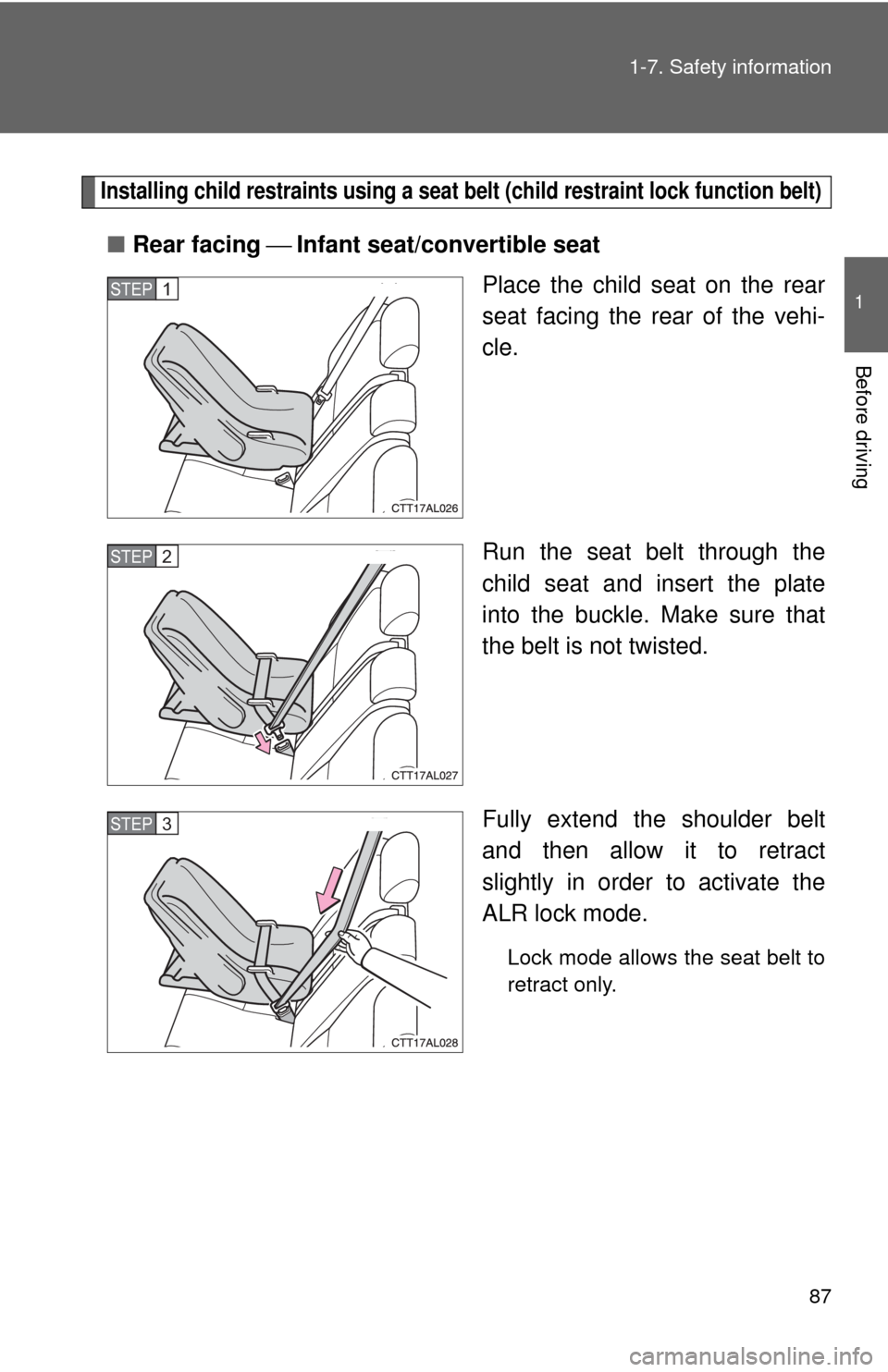
87 1-7. Safety information
1
Before driving
Installing child restraints using a seat belt (child restraint lock function belt)
■Rear facing ⎯ Infant seat/convertible seat
Place the child seat on the rear
seat facing the rear of the vehi-
cle.
Run the seat belt through the
child seat and insert the plate
into the buckle. Make sure that
the belt is not twisted.
Fully extend the shoulder belt
and then allow it to retract
slightly in order to activate the
ALR lock mode.
Lock mode allows the seat belt to
retract only.
STEP1
STEP2
STEP3
Page 88 of 440
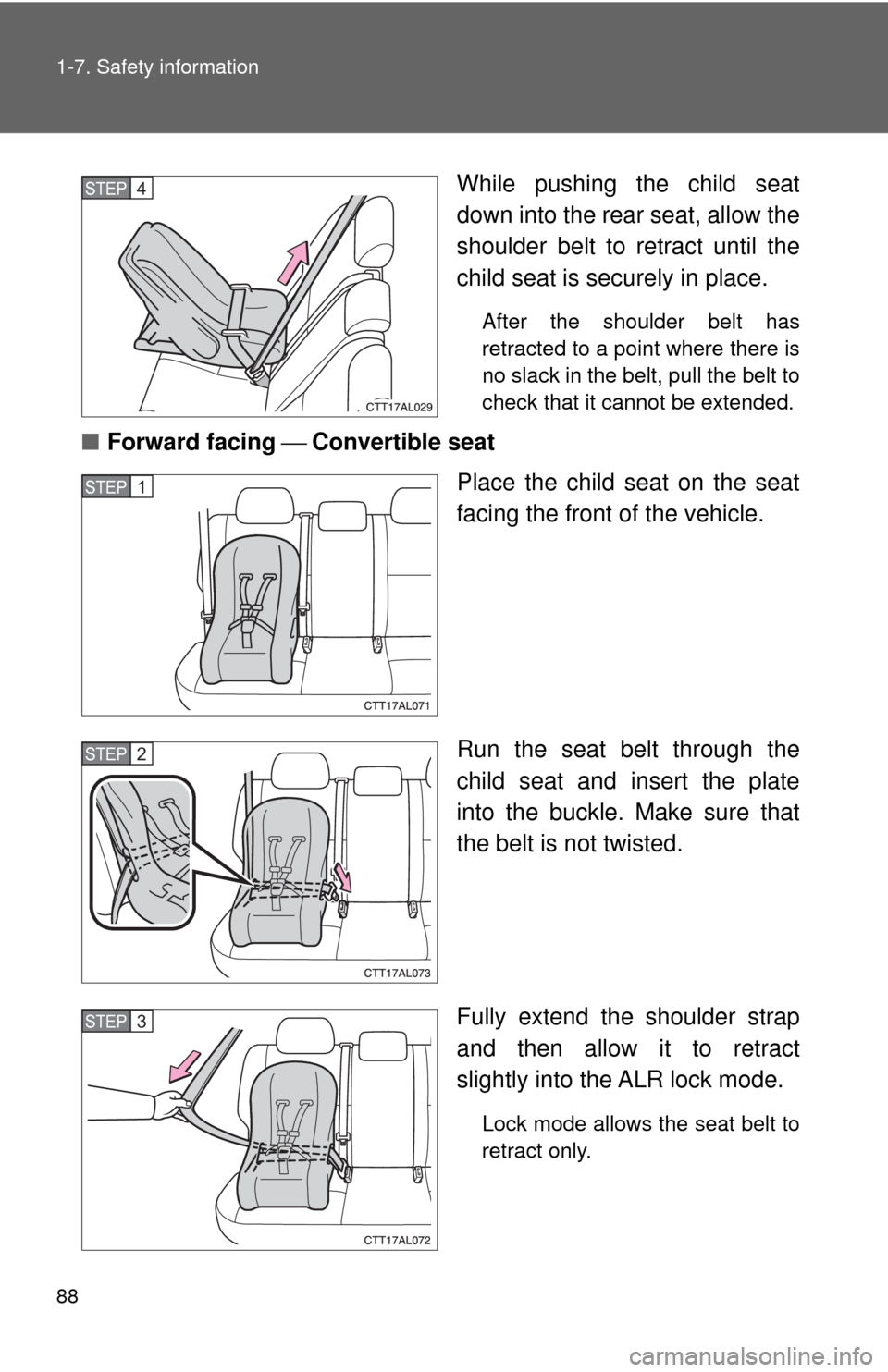
88 1-7. Safety information
While pushing the child seat
down into the rear seat, allow the
shoulder belt to retract until the
child seat is securely in place.
After the shoulder belt has
retracted to a point where there is
no slack in the belt, pull the belt to
check that it cannot be extended.
■Forward facing ⎯ Convertible seat
Place the child seat on the seat
facing the front of the vehicle.
Run the seat belt through the
child seat and insert the plate
into the buckle. Make sure that
the belt is not twisted.
Fully extend the shoulder strap
and then allow it to retract
slightly into the ALR lock mode.
Lock mode allows the seat belt to
retract only.
STEP4
STEP1
STEP2
STEP3
Page 89 of 440
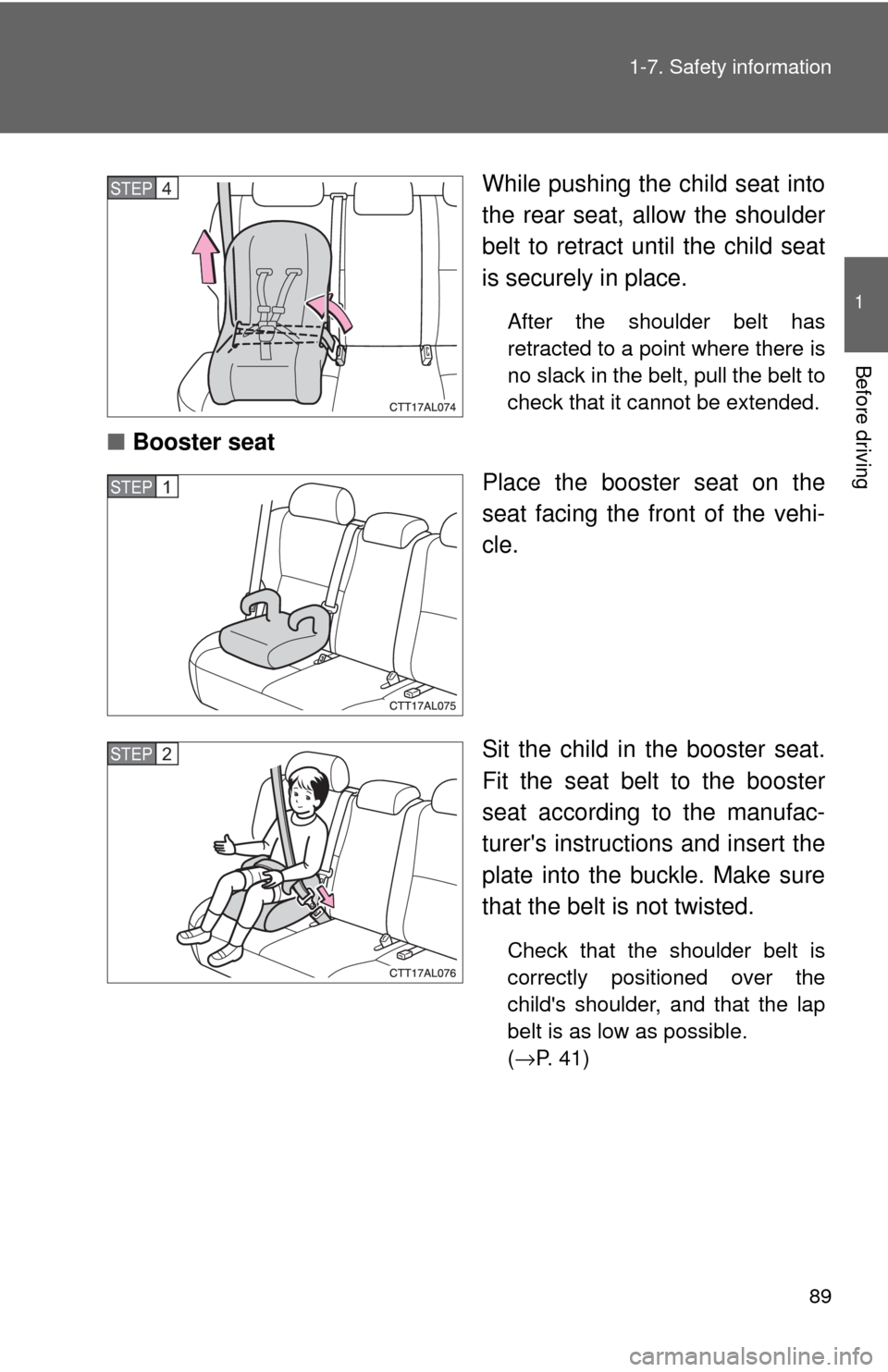
89 1-7. Safety information
1
Before driving
While pushing the child seat into
the rear seat, allow the shoulder
belt to retract until the child seat
is securely in place.
After the shoulder belt has
retracted to a point where there is
no slack in the belt, pull the belt to
check that it cannot be extended.
■Booster seat
Place the booster seat on the
seat facing the front of the vehi-
cle.
Sit the child in the booster seat.
Fit the seat belt to the booster
seat according to the manufac-
turer's instructions and insert the
plate into the buckle. Make sure
that the belt is not twisted.
Check that the shoulder belt is
correctly positioned over the
child's shoulder, and that the lap
belt is as low as possible.
(→P. 41)
STEP4
STEP1
STEP2
Page 90 of 440
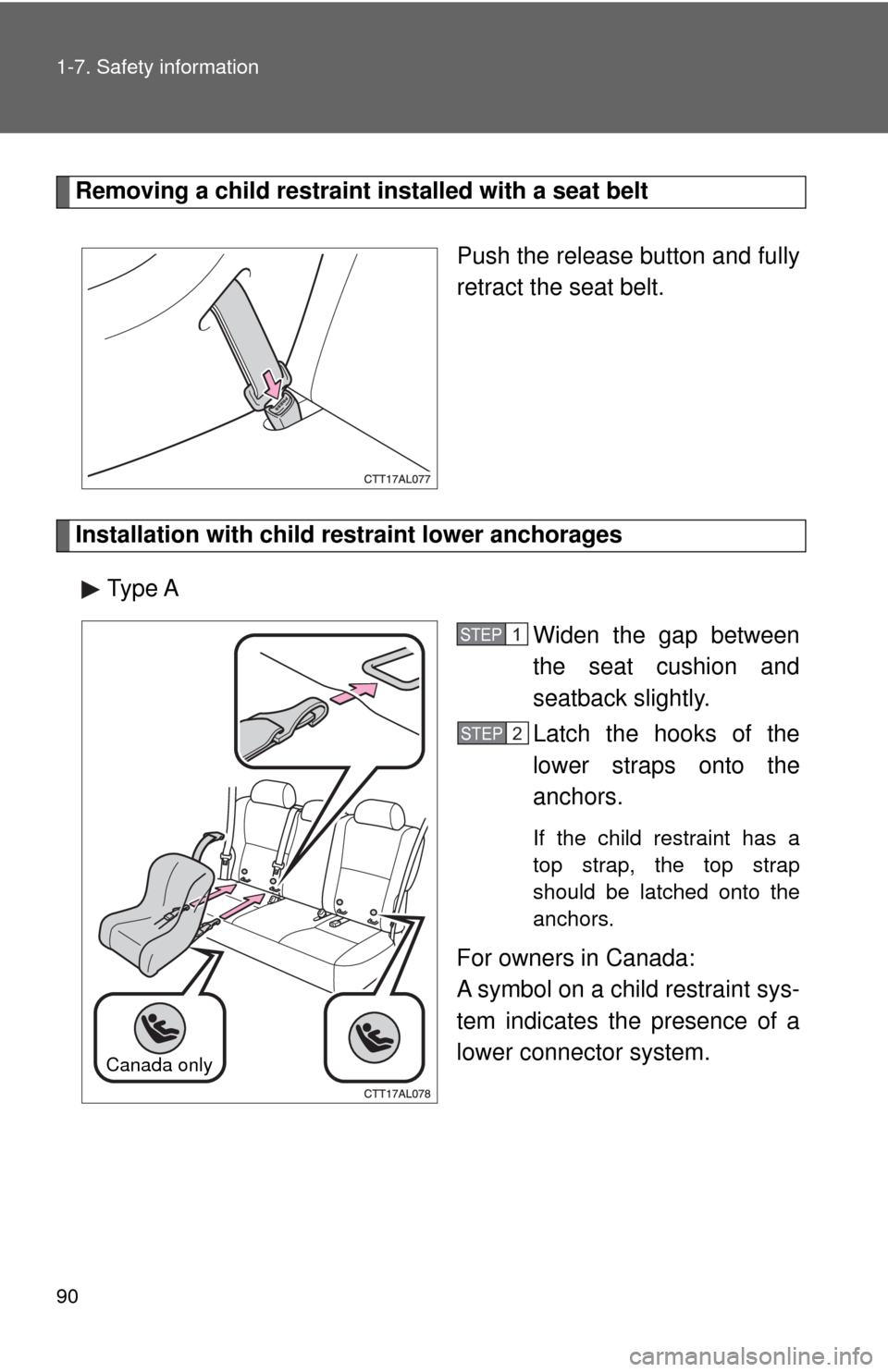
90 1-7. Safety information
Removing a child restraint installed with a seat belt
Push the release button and fully
retract the seat belt.
Installation with child restraint lower anchorages
Type A
Widen the gap between
the seat cushion and
seatback slightly.
Latch the hooks of the
lower straps onto the
anchors.
If the child restraint has a
top strap, the top strap
should be latched onto the
anchors.
For owners in Canada:
A symbol on a child restraint sys-
tem indicates the presence of a
lower connector system.
Canada only
STEP1
STEP2